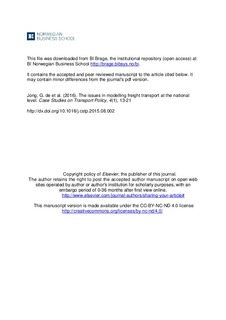| dc.contributor.author | Jong, Gerard de | |
| dc.contributor.author | Tavasszy, Lori | |
| dc.contributor.author | Bates, John | |
| dc.contributor.author | Grønland, Stein Erik | |
| dc.contributor.author | Huber, Stefan | |
| dc.contributor.author | Kleven, Oskar | |
| dc.contributor.author | Lange, Peter | |
| dc.contributor.author | Ottemöller, Ole | |
| dc.contributor.author | Schmorak, Nora | |
| dc.date.accessioned | 2017-04-06T07:52:51Z | |
| dc.date.available | 2017-04-06T07:52:51Z | |
| dc.date.issued | 2016 | |
| dc.identifier.citation | Case Studies on Transport Policy, 4(2016)1, 13-21 | nb_NO |
| dc.identifier.issn | 2213-624x | |
| dc.identifier.issn | 2213-6258 | |
| dc.identifier.uri | http://hdl.handle.net/11250/2436936 | |
| dc.description | The accepted and peer reviewed manuscript | nb_NO |
| dc.description.abstract | Several countries in Europe and elsewhere have a national freight transport model. This paper discusses some old and new issues for these models, based on experiences in at least seven European countries. These issues have to do with the institutional organisation of the work on model development and use, how confidence in these models can be determined and increased, the questions the national freight models are asked and their scope and level of detail. But also what the model philosophy (e.g. aggregate, disaggregate, deterministic, stochastic) should be and which influencing factors should be included. New directions are discussed, such as the trend to include more aspects of logistics decisions of firms. This increases the data requirements of the models. The potential of big data is discussed as well as approaches that use less data but more assumptions. | nb_NO |
| dc.language.iso | eng | nb_NO |
| dc.publisher | Elsevier | nb_NO |
| dc.title | The issues in modelling freight transport at the national level | nb_NO |
| dc.type | Journal article | nb_NO |
| dc.type | Peer reviewed | nb_NO |
| dc.source.journal | Case Studies on Transport Policy | nb_NO |
| dc.identifier.doi | http://dx.doi.org/10.1016/j.cstp.2015.08.002 | |
| dc.description.localcode | 1. Forfatterversjon | nb_NO |
